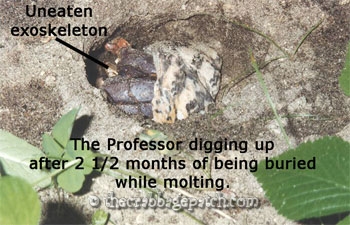|
My Learning Curve For years I owned jumbo hermit crabs as pets. Sadly they would always die after about a year. That was until The Professor taught me that hermit crabs need to bury underground to survive the stressful process known as molting. Often I am asked why I am drawn to hermit crabs as a pet. My interest began years ago when I was in 7th grade and saw these fascinating and unusual creatures in a new pet shop. The hermit crabs they had were of the species Coenobita clypeatus, commonly referred to as the "purple pincher crab" and they were the size of a baseball. I was instantly hooked! The pet shop owner was very patient and taught me how to properly handle the crabs and showed me that there wasn't any reason to be afraid of them. I came home with my first pet jumbo hermit crab that I named "Lias". Since then, my interest has become an obsession. It's amazing to me when I think back to the early days and realize the impact this creature has had on my life. For years I had jumbo crabs, usually one at a time, as pets. At around the 1 year mark, they would always die. I would be devastated and often swear off having another crab for fear of the same end result. Finally, I would give into temptation since I loved these creatures so much. Each time, I would try something different, thinking that it was something that I was doing incorrectly. The frustrating part was that I was following instructions outlined in the few hermit crab books on the market at that time. During that time I was keeping my jumbo crabs on an inch or so of fish gravel in a 10 gallon aquarium. I was providing hermit crab food and a bowl of fresh water, but unfortunately my jumbos would die when it was time to molt. I switched to a few inches of beach sand in my cage when I moved to Florida but still lost my crabs after about a year. Then one day something amazing happened!
My husband and I were sitting outside and I had my jumbo crab (The Professor) out and was watching him roam the backyard. He started digging. We didn't know what he was doing so we watched and eventually he completely buried himself! At this point we were not quite sure what to do. I brought a plastic laundry basket out to where he was buried, turned it upside down over where he went down and put a cement block on top in case he tunneled back up. Throughout the following days I would frequently check the area where he buried to see if he had re-surfaced. Finally, after almost 3 months of waiting, I found him digging back up from his underground cave. I picked him up and he had needle-sharp nails, lots of shaggy blond sensory hair (setae) and his exoskeleton was shiny and new looking; he had molted! I was so excited, I finally had a hermit crab that molted and he buried below ground to do it!
I decided to visit the University of Miami's research library on Key Biscayne to see what I could find out about molting in crustaceans. I learned about the dual hormones involved in the molting process and how environmental factors contribute to and determine which hormone is secreted. Ecdysone: MH, the molting hormone, is secreted from the Y organs located in the anterior part of the thorax. MIH, the molt inhibiting hormone, is produced in the eyestalk. Conditions such as darkness, solitude, warmth and moisture contribute to the secretion of the MH whereas, unfavorable conditions such as light, other crabs nearby, excessive cold or heat and dryness cause the MIH to be secreted in the hope that conditions will become favorable to molt. This was a "light bulb moment" for me. When a crab is able to bury underground, into a protected, isolated, insulated environment of total darkness, the molting hormone (MH) will be secreted and molting will commence. Likewise, crabs that are unable to bury will experience unfavorable conditions and will secrete the MIH to delay molting until conditions became favorable to bury. But what happens if conditions remain unfavorable for too long? My theory is that secretion of the MIH is a short term means of protection. If poor conditions persist, the MIH builds within the hermit crabs body to a "toxic" level and the crab reaches a point of no return. The crab will not be able to survive the molting process, even if conditions finally become favorable. This happens frequently to crabs kept on fish gravel, shallow sand or coco fiber in crowded conditions such as often seen in many pet shops, mall kiosks and surf shops. Unfortunately many of these poor crabs will begin to drop limbs or claws and eventually die. It's a horrible and helpless thing to experience and usually the end result is always the same...the crab doesn't survive. I believe that their ability to delay molting varies according to the size of the crab. A jumbo can go much longer without molting than a smaller crab who is actively still growing . Eventually, some crabs will try to molt regardless of the conditions. As with any animal, the young crabs are more resilient and can often survive a surface molt. I have never had a Jumbo crab survive a molt attempt above ground. Usually they are not able to fully shed their old exoskeleton. It was back in 1996 that The Professor buried in the back yard. I changed the way I set up my tanks (adding very deep, moist sand) and I still have several of my pet crabs from that year with me today. |
